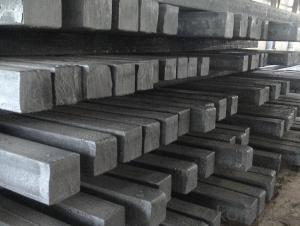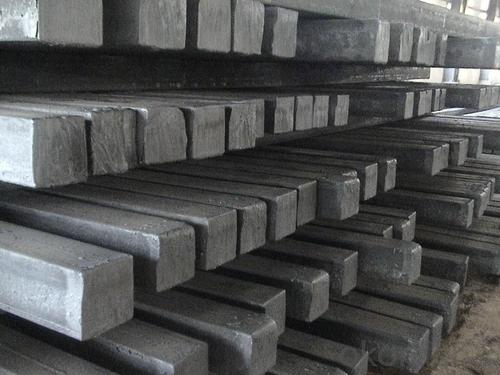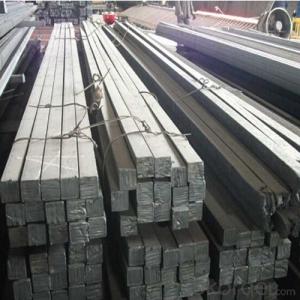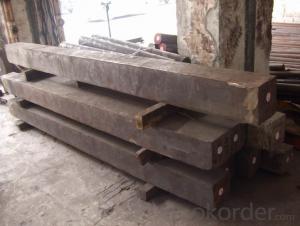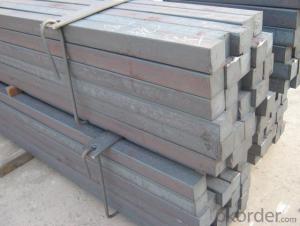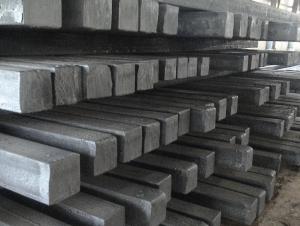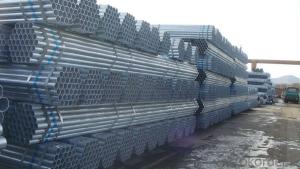hot rolled square steel billets
- Loading Port:
- China Main Port
- Payment Terms:
- TT OR LC
- Min Order Qty:
- -
- Supply Capability:
- -
OKorder Service Pledge
OKorder Financial Service
You Might Also Like
Product Description:
Packaging & Delivery
| Packaging Detail: | in bundles |
| Delivery Detail: | according to the quantity |
Specifications
square steel billet
1.3SP, 5SP
2.terms of payment: L/C at sight
3.size: 120*120mm
4.length: 5.8~12m
square steel billet
Specifications
square steel billets
1)We procure world class quality steel billets which meets the specific requirements of the clients
The Billets produced by the company can be broadly divided into three main types i.e.
M.S. Billets
CRS Billets
Special Alloy Billets
M.S. Billets are used for rolling of TMT Re-Bars of Fe415 and Fe500 Grade and various other structural steel products.
CRS Billets are used fro rolling of CRS TMT Re-Bars.
Special Alloy Billets are used for rolling of any special grade TMT Re-Bars like Earthquake resistant TMT Re-Bars and for special grade structural steel products.
The following are the sizes of Billets available with Shyam Steel Industries Ltd.:
100 X 100
120x120
150 X 150
Physical Properties:
Description | As per IS 2830 | Shyam Billets |
| Bend (max.) | 5 mm per meter | >= 5 mm per meter |
| Carbon (max.) | 3mm per meter | >= 3 mm per meter |
| Length | 3 mt - 13 mt | 3 mt - 9 mt |
Chemical Properties:
Ladle Analysis: | ||
Designation | Carbon | Manganese |
| C15 | 0.12-0.18 | 0.30-0.60 |
| C18 | 0.15-0.21 | 0.30-0.60 |
| C20 | 0.17-0.23 | 0.30-0.60 |
| C15 MMn | 0.12-0.18 | 0.60-1.00 |
| C18 MMn | 0.15-0.21 | 0.60-1.00 |
| C20 MMn | 0.17-0.23 | 0.60-1.00 |
| C15 HMn | 0.12-0.18 | 1.00-1.50 |
| C18 HMn | 0.15-0.21 | 1.00-1.50 |
C20 HMn | 0.17-0.23 | 1.00-1.50 |
Billets of different designations are manufactured in three different grades namely A, B, C having sulphur, phosphorous content (on ladle analysis) and carbon equivalent as follows:
| Chemical Analysis: | |||
| Grade | Sulphur | Phosphorous | Carbon Equivalent (CE)1 |
| Max | Max | Max | |
| A | 0.05 | 0.05 | 0.42 |
| B | 0.045 | 0.045 | 0.41 |
| C | 0.04 | 0.04 | 0.39 |
- Q: Can a steel square be used for measuring the thickness of glass?
- No, a steel square cannot be used for measuring the thickness of glass. A steel square is a tool typically used in carpentry and woodworking to measure angles and ensure accurate right angles. It is not designed or suitable for measuring the thickness of glass. To measure the thickness of glass, specialized tools such as calipers or micrometers are typically used, which provide precise measurements.
- Q: How does a steel square assist in determining the correct angle for a beaded joint?
- There are several ways in which a steel square can be utilized to determine the correct angle for a beaded joint. To begin with, the steel square possesses a 90-degree angle that can be employed as a point of reference to ensure that the beaded joint is perfectly perpendicular to the workpiece. By placing the square against the workpiece and aligning it with the joint, one can visually verify whether the joint is at a right angle or necessitates adjustment. Furthermore, the steel square enables the measurement and transfer of angles. Along its edges, the square typically features various degree markings that facilitate precise angle measurements. This proves particularly advantageous when dealing with beaded joints that require specific angles, such as mitered corners or angled cuts. By utilizing the square as a guide, one can accurately mark the desired angle on the workpiece and guarantee a precise beaded joint. Moreover, the steel square can function as a guide during the cutting or shaping of materials for the joint. By aligning the square with the workpiece and marking the desired angle, one can utilize the square as a reference point during the cutting or shaping process. This aids in achieving accurate and consistent angles across multiple pieces, resulting in a well-fitted and aesthetically pleasing beaded joint. In summary, a steel square proves indispensable in determining the correct angle for a beaded joint by virtue of its ability to provide a 90-degree reference, facilitate angle measurements and transfers, and serve as a guide during cutting and shaping operations. Its versatility and precision make it an essential tool for ensuring the accuracy and quality of beaded joints.
- Q: Can a steel square be used for checking the squareness of picture hanging systems?
- Yes, a steel square can be used for checking the squareness of picture hanging systems. A steel square is a tool commonly used in carpentry and woodworking to ensure accuracy and squareness. It has a right angle shape and provides a reliable reference for measuring and checking squareness. By placing the steel square against the edges of the picture hanging system, you can determine if it is properly aligned and perpendicular to the wall.
- Q: How do you use a steel square for framing walls?
- To use a steel square for framing walls, first, ensure that the square is clean and free of any debris. Next, position the square on the edge of the lumber, ensuring that one leg is flush against the edge and the other leg is perpendicular to it. To mark a straight line, hold the square firmly against the edge of the lumber and use a pencil or a marker to trace along the edge of the square's leg. This will give you a precise guide for making straight cuts or marking measurements. For making angled cuts, such as for roof rafters or stair stringers, the steel square can be used to determine the angle. Position the square on the lumber so that the desired angle aligns with the edge of the square, and mark the line accordingly. Additionally, the steel square can be used for determining squareness and checking for right angles. By placing the square in the corner of two intersecting walls, you can ensure that the corner is perfectly square. If the square fits snugly and the legs align with the walls, then the corner is square. If not, adjustments can be made accordingly. Overall, the steel square is a versatile and essential tool for framing walls, allowing for precise measurements, straight cuts, angled cuts, and ensuring the accuracy of corners.
- Q: How do you use a steel square for making accurate crosscuts?
- Achieving accurate crosscuts can be done by following these steps with the assistance of a steel square: 1. Prepare your workspace: Begin by clearing the area and ensuring that you have a stable surface to work on. This will help prevent unintended movement or inaccuracies while cutting. 2. Mark your desired crosscut: Use a pencil or marking knife to precisely mark the line where you want to make the crosscut on the surface you're working on. Make sure the marking is clear and precise. 3. Position the steel square: Align the steel square with the marked line, placing it against the material's edge. Ensure that the square is securely held and does not shift during the subsequent steps. 4. Secure the square: If necessary, use clamps or other methods to firmly secure the steel square to the material. This will maintain accuracy and prevent movement during the cutting process. 5. Guide your saw: Utilize a handsaw or circular saw with a guide, positioning it against the edge of the steel square. Verify that the saw blade aligns with the marked line and that the square serves as a reference and guide for the saw. 6. Make the crosscut: Guide the saw carefully and steadily along the edge of the steel square, following the marked line. Apply consistent pressure and maintain a smooth motion throughout the cut. 7. Double-check: Once the crosscut is complete, inspect the cut line to ensure it aligns accurately with the marked line. Make any necessary adjustments or corrections as needed. By employing a steel square as a guide, precise and accurate crosscuts can be achieved in woodworking or other projects. Always prioritize safety by wearing appropriate protective gear and utilizing the correct tools for the task at hand.
- Q: What are some common techniques for using a steel square in boat building?
- Using a steel square in boat building is a common practice that helps ensure accurate measurements and angles during construction. Here are some common techniques for using a steel square in boat building: 1. Checking squareness: A steel square is used to check the squareness of bulkheads and frames. By placing the square against the edges of these components, boat builders can ensure that they are perfectly perpendicular to the boat's centerline. 2. Measuring angles: Boat builders use a steel square to measure angles accurately. By aligning one leg of the square along the reference line and the other leg at the desired angle, they can mark the correct angle on the boat's structure. 3. Transferring measurements: Steel squares are used to transfer measurements from plans to the boat's structure. Builders can align the square with the reference line and then mark points, lines, or angles on the boat's components. 4. Checking bevel angles: Bevel angles are essential in boat building, particularly for joining planks or panels. A steel square can be used to determine the correct bevel angle by aligning the square with the reference line and adjusting it until the desired angle is achieved. 5. Checking diagonals: Boat builders use a steel square to check diagonal measurements on the boat's structure. By measuring both diagonals and ensuring they are equal, they can confirm that the boat is symmetrical and accurately constructed. 6. Aligning components: Steel squares are also used to align components during boat assembly. By placing the square against the edges of different parts, builders can make sure they are perfectly aligned before fastening them together. 7. Creating straight lines: A steel square is a useful tool for drawing straight lines on boat components. By aligning one leg of the square with the edge of the material, builders can easily draw a straight line parallel to it. In conclusion, a steel square is an invaluable tool in boat building, helping boat builders achieve accuracy and precision in their measurements, angles, and alignments.
- Q: How do you use a steel square to determine the length of a stringer?
- To determine the length of a stringer using a steel square, follow these steps: 1. Place the steel square on the edge of the stringer, ensuring that one arm aligns with the edge and the other arm is perpendicular. 2. Slide the square along the stringer until the perpendicular arm reaches the desired length. 3. Mark the stringer at the end of the perpendicular arm. 4. Remove the steel square and measure the distance between the mark and the starting point of the stringer using a tape measure or ruler. This measurement will provide the accurate length of the stringer. It is worth noting that a steel square is a versatile tool utilized for various carpentry and construction tasks. Its L-shaped design enables precise measurements and angles. By employing it correctly, you can guarantee accurate and precise measurements for your stringer or any other woodworking project.
- Q: Can a steel square be used for plumbing tasks?
- Indeed, plumbing tasks can indeed make use of a steel square. Although its primary purpose lies in carpentry, where it serves to measure and designate right angles, a steel square can also prove advantageous in plumbing tasks. One noteworthy application is its ability to guarantee the correct alignment and perpendicularity of pipes to walls or floors. Furthermore, it can aid in measuring and marking cuts on pipes and other plumbing materials. Nevertheless, it is crucial to acknowledge that plumbing-specific tools, like pipe wrenches and pipe cutters, might be more appropriate and efficient for certain plumbing jobs.
- Q: Can a steel square be used for measuring angles in masonry work?
- No, a steel square is not typically used for measuring angles in masonry work. Masonry work usually requires specialized tools like a mason's square or a protractor specifically designed for measuring angles in this field.
- Q: What are the different types of steel squares used in metalworking?
- In metalworking, steel squares are essential tools used for measuring, marking, and checking right angles in various applications. There are several types of steel squares commonly used in metalworking, each with its own specific features and advantages. 1. Engineer's Square: This type of square is the most commonly used in metalworking. It typically has a blade that is longer than its beam, allowing for easier measurement of larger workpieces. Engineer's squares are known for their accuracy and are ideal for general layout work. 2. Machinist's Square: Machinist's squares are precision tools used for extremely accurate measurements. They have a hardened blade and a heavier construction than engineer's squares, providing improved stability and accuracy. Machinist's squares are commonly used for setup and alignment tasks. 3. Combination Square: Combination squares are versatile tools that combine a square, level, and protractor in one device. They usually consist of a steel rule with a sliding head that can be locked at different angles. Combination squares are useful for measuring, marking, and checking angles, as well as for setting depths and heights. 4. Try Square: Try squares, also known as tri-squares, have a shorter blade and beam than engineer's squares. They are primarily used for checking and marking right angles on smaller workpieces, such as woodworking projects. Try squares are lightweight and easy to handle. 5. Miter Square: Miter squares are specialized squares used for accurately marking and cutting angles for miter joints. They have adjustable blades that can be set at different angles. Miter squares are commonly used in woodworking and carpentry, but they can also be useful in metalworking when precise angled cuts are required. These are just a few examples of the different types of steel squares used in metalworking. Each square serves a specific purpose, providing metalworkers with the necessary tools to ensure accurate measurements, precise marking, and the creation of well-aligned structures.
Send your message to us
hot rolled square steel billets
- Loading Port:
- China Main Port
- Payment Terms:
- TT OR LC
- Min Order Qty:
- -
- Supply Capability:
- -
OKorder Service Pledge
OKorder Financial Service
Similar products
Hot products
Hot Searches
Related keywords
